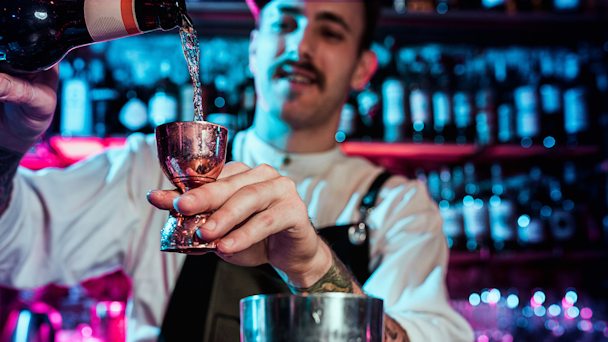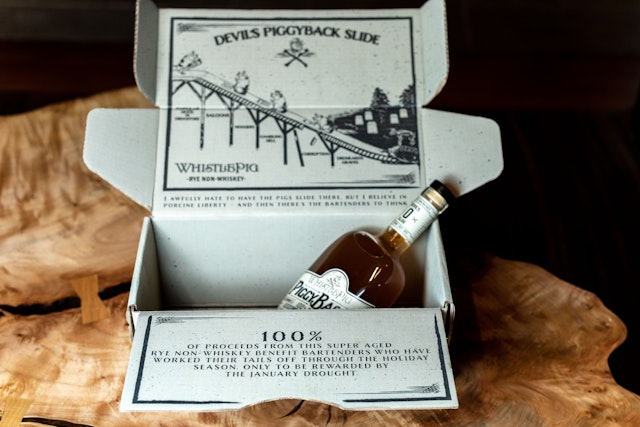Why the ‘sober-curious’ will spur zero-alcohol sales well beyond Dry January
Corona now has a Vitamin D-infused alcohol-free beer. WhistlePig is serving up 0% alcohol whiskey shots. Meanwhile, Heineken 0.0 and Athletic Brewing continue to rake in the sales. Here’s what you need to know about the growing power of the ‘sober-curious’ consumer.

Big beer brands and craft cocktail connoisseurs alike are pouring up new zero-alcohol beverages
Alcohol is an integral part of American culture — and in recent years, it’s only become more so: 75% of US drinkers report to be consuming more booze since the onset of the pandemic two years ago.
Even so, with each new year comes a wave of consumers eager to hit the brakes on their alcohol habit and start the new year off on a lower-alcohol and lower-calorie note. Last year, per Morning Consult data, 13% of Americans said they’d be participating in Dry January, a popular campaign in which drinkers pledge to eliminate alcohol for the first month of the year. The number was up from 11% of Americans who said they’d participated in Dry January before.
This year’s numbers are yet to be tallied, but it isn’t stopping brands from tapping into the commercial potential of the month-long event with new low- and no-alcohol products and ad campaigns to boot.
Thirsty for choice? Non-alcoholic options abound
It’s not just Dry January initiatives sparking sales of low- and no-alcohol beverages: over the last few years, new health-conscious or ‘sober-curious’ consumers have helped spur the impressive growth of the category. From late 2020 to late 2021, non-alcoholic beer, ciders and malt beverages witnessed a 31.7% lift in sales, while and non-alcoholic wine sales grew nearly 40%, per NielsenIQ data.
“Non-alcoholic beer is growing… pretty solidly,” says David Steinman, senior editor at Beer Marketer’s Insights. Steinman says that, as it stands, Heineken is the definitive category leader. Its Heineken 0.0 hit global shelves in 2017 and made its way to the US in 2019; it’s since become the most popular non-alcoholic beer on the market. Heineken confirms this fact; the company tells The Drum that Heineken 0.0 owns 71% of category growth in off-premise sales (meaning purchases made at retail) and 20.7% of the market share, as of the third quarter of 2021.
Borja Manso Salinas, vice president of marketing at Heineken USA, predicts that growth won’t slow anytime soon. “This is just the beginning for the [non-alcoholic beverage] category, with consumers continuing to drive demand for a wide variety of beverage options,” he says. “Pushing the category forward is the rise of the sober-curious consumer: someone who drinks alcohol but at times chooses to abstain. The category isn’t growing because consumers are suddenly deciding to give up alcohol, rather it’s growing because consumers who drink alcohol are discovering that great-tasting non-alcoholic options like Heineken 0.0 can fit into their lifestyle, too.”
He says that in 2022 the company will “continue to evaluate growth opportunities for 0.0 within non-alcohol across line extensions, pack types, channels [and more].” One of these moves is transitioning 0.0 to new packaging beginning in Q3. Following extensive market research, the brand found that — with nearly a third of the total volume of premium beer, cider and flavored malt beverages now sold in slim cans — consumers see slim cans, rather than traditional wider cans, as “more premium, exciting, imported, and modern than current cans,” per Salinas.
Heineken isn’t the only major label investing big dollars in the segment. ABInBev debuted Budweiser Zero in the summer of 2020, and since then, the brand has picked up a key share of the growing market. Daniel Blake, group vice-president of marketing at Budweiser & Value, believes the label is especially well-positioned to capture a larger portion of the segment “as America’s most iconic beer brand.” He says that Budweiser Zero “brings a familiarity and brewing heritage into the category and helps redefine the non-alcoholic space.”
This Wednesday, Corona — also owned by ABInBev — announced it is launching a Vitamin D-infused zero-alcohol offering christened Corona Sunbrew in Canada. The brand teamed with creative agency DAVID Miami to launch a multichannel ad campaign to promote the new drink — just in time for Dry January.
And outside of beer’s biggest players, a handful of craft brewers and category newcomers are also shaking up the space. Among the most notable is Athletic Brewing, a Stratford, Connecticut-based brewer making exclusively non-alcoholic beers. The company, just four years old, already commands 45% of the craft non-alcoholic beer category and approximately 8% of the total US non-alcoholic beer segment, per a report put out last week by the San Diego Union-Tribune. Last month, the brand released its new limited-edition Dry January Party Pack, a variety 30-pack that retails for $59.99 in the US.
Spirits take their shot
But it’s not just beer brands tapping into the movement: spirits brands are increasingly experimenting with low- and non-alcoholic offerings.
On Monday, WhistlePig, a Vermont-based craft whiskey maker, decided to enter the non-alcoholic market for the first time. It rolled out WhistlePig PiggyBack Devil’s Slide, a collection of 100% rye aged non-alcoholic whiskeys, including a standard take on its PiggyBack label, a CBD-infused variety dubbed “Devil’s Half Send” and a theoretical THC-infused variety — which vice-president of marketing and innovation Eliza McClure says the company will release if marijuana laws ever allow — aptly named “Devil’s Full Send.”
To support the roll-out, WhistlePig launched a Dry January campaign, complete with site branding and labels inspired by a temperance era piece of propaganda known as the “Devil’s Toboggan Slide” that pokes fun at the idea that drinking whiskey — whether alcoholic or non-alcoholic — will corrupt the drinker. “It’s a really cluttered space, both in terms of the fast pace of non-alc [products hitting the shelves] and the crowded nature of the whiskey space and how many new launches are coming to the market every month,” says McClure. “We like to stand out…by pushing the envelope a little bit further, and taking people to an unexpected place and being a bit irreverent about it.”

By focusing its marketing efforts on its playful, nontraditional branding, WhistlePig hopes it can attract the attention of health-conscious and sober-curious drinkers. The campaign includes social and email assets encouraging Dry January pledgors to try one of the new whiskeys. The company has promised to donate 100% of the proceeds from its Devil’s Slide collection to bartenders who have been impacted by the economic backlash of the pandemic.
A range of other distillers are accelerating growth in the category, including Ritual, Lyre’s and Seedlip, all of which exclusively produce zero-alcohol spirits. Now, growth in the non-alcoholic spirits space, according to some measures, is already outpacing the non-alcoholic beer, wine and malt beverages segment: NielsenIQ data indicates that year-over-year, the non-alcoholic spirits category ballooned 113.4%; on delivery app Drizly, category sales were even higher — they spiked 290% in 2021.
Beyond Dry January
Though the beer, wine and spirits industry has seen plenty of fads (remember wine coolers? Ice beer?), experts predict that low- and non-alcoholic booze is here to stay — and that brands will move beyond Dry January campaigns and start marketing these alternatives year-round.
“We’ve been witnessing a strong cultural shift in how consumers relate to alcohol,” says Heineken USA’s Salinas. “While non-alcoholic beverages were once reserved for those who completely abstained from alcohol, we’re starting to see non-alcoholic beverages used as a moderation option that fits in alongside other alcoholic beverages. So even if people aren’t abstaining from alcohol or they give up in the middle of Dry January, low-cal and low-alcohol beverages are good options for a moderation-focused lifestyle.”
He also points out that consumers’ rising interest in health and wellness will shape long-term market movements and is likely to drive the continuous growth of the low- and non-alcoholic beverage sector. “The sober-curious movement is extending beyond the month of January as more people are increasingly reaching for healthier beverage options on a year-round basis. Mindful drinking is on the rise, and there will continue to be substantial interest.”
Even so, Salinas acknowledges that shorter-term commitments like Dry January and more recent addition Sober October present valuable strategic marketing opportunities for brands like Heineken. “With the rise of short-term challenges like Dry January and Sober October, we know consumers are being more intentional about when they drink alcohol and when they choose to abstain. Our [goal] is to make sure consumers know Heineken has a great-tasting option, whether they are consuming alcohol or not.”

